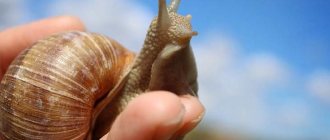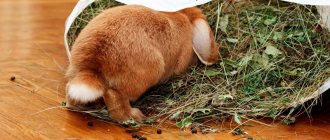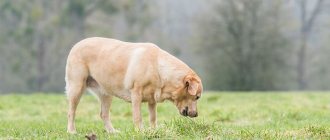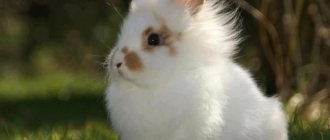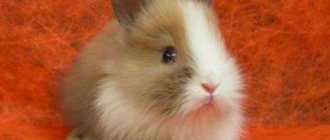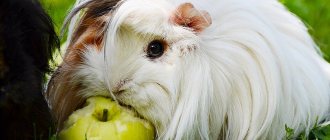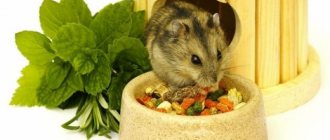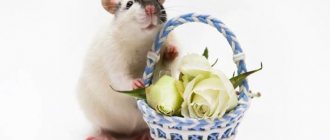Permitted plants
Many novice rabbit breeders wonder whether vetch, lupine and alfalfa can be given to rabbits. Yes, these are representatives of seeded grasses, which should make up the majority of the diet. But in order to save money, many people prefer wild crops growing in forests, fields and even garden plots.
Healthy rabbit for home raising of the giant breed
Note! By using green plants for feeding, you can reduce the concentration of feed and grain crops in the diet. In the future, this will have a beneficial effect on the cost of fur skins, down and meat products
Only young grass, the composition of which is rich in fiber and protein, can be used as feed. It is no longer recommended to give “adult” plants, since their concentration of nutrients is lower and they are less easily absorbed by the animal’s body.
The diet of pets should be varied; one type of herb cannot be used on an ongoing basis. A common question is whether it is possible to feed rabbits fresh grass. It is possible, but not often and not in large quantities. It is better to wilt all the greens first, so they will be better absorbed.
What grass can be given to rabbits:
- coltsfoot;
- wheatgrass;
- plantain;
- dandelion officinalis;
- stinging nettle;
- alfalfa;
- tansy.
For your information! Bonfire grass for rabbits is also recommended for use; its composition is rich in vitamins and minerals.
Now it’s worth familiarizing yourself in more detail with the beneficial properties and secrets of collection and preparation.
| Plant name | Useful properties for rabbits | Brief description and features |
| Sagebrush |
| Wormwood has a pronounced anthelmintic effect. Consumption in large quantities causes nervous excitement in individuals. |
| Medicinal dandelion |
| It is recommended to introduce it into the diet in combination with other herbs. The daily amount should not exceed 30% of the total volume. Abuse of the plant leads to developmental delays. |
| Plantain |
| It grows between fields, meadows and roadsides. |
| Siberian hogweed | Grows between bushes in forest fields. It begins to bloom in June or July, depending on the region of growth. Only the leaves can be used as food. |
Coltsfoot plant
Note! If the plants are to be used as hay, they must be mowed before the buds begin to form. There is no point in drying the grass for a long time; the hay should have a green color and a pleasant, fresh aroma
Sowing green food on the site
This option is preferable for those who do not have much time to wander through the meadows and collect. On your site you can plant all types of herbs that are beneficial for rabbits:
- legumes - they are nutritious and healthy;
- red clover - when buds begin to set, it will contain 21% protein. You can also use hybrid and mountain types of clover; these crops are also rich in protein. All rabbits eat such clover with great appetite;
- Alfalfa is high in protein and amino acids. Alfalfa is no less useful for rabbits than clover, and it grows well in different climatic zones. It should be mowed immediately after the first flowers form;
- oats. It can be sown twice per season, planting the second batch immediately after mowing the first;
- borage and phacelia - they require deep planting, but are very tasty and healthy for eared ears;
- green peas - dried pods and stems are eaten;
- celery and parsley - can increase the appetite of animals;
- vetch – when feeding it should be mixed with oats;
- rye – it and vetch are given together as feed;
- corn – young stalks are added to the diet, combining corn with legumes. Corn and legumes are combined 70% to 30%;
- Sida is an ornamental plant that is pollinated by bees and honey is collected from it. It grows for many years and can be mowed twice during the summer. There are no less proteins in the plant than in clover and alfalfa;
- sulfia - like sida, it is rich in nutrients, it is also mowed twice in the summer;
- rhubarb - they begin to harvest it in early spring, when other herbs have not yet begun to grow and it is too early to mow them. Rhubarb is a perennial plant; rabbit breeders often grow it to feed their animals;
- fodder lupine - belongs to the legume family. Unlike yellow lupine, which causes lupinosis (poisoning due to the high content of alkaloids), the food version contains a lot of protein. It is not recommended to give rabbits only one lupine, otherwise they will have indigestion;
- amaranth - blooms beautifully in the area, does not require special care, has a beneficial effect on the digestive system of animals;
- dill, cumin and mint make rabbit meat taste good and more aromatic.
Useful qualities of herbs
The benefits of feeding green herbs can hardly be overestimated:
- The green mass is easily digested by the delicate stomachs of rabbits and is quickly absorbed by the body.
- The fiber contained in the grass has a positive effect on the digestive system and prevents constipation.
- Such nutrition stimulates rapid growth. This is especially affected by legumes containing large amounts of protein and amino acids.
- Eating the stems causes the rodents' teeth to wear down.
- The quality of the wool is improved, which is especially important when growing downy breeds.
The advantages of this type of food include the fact that grass, both in the garden and wild, grows on its own. You just have to spend time mowing it.
Rabbit grass can be used as a green pharmacy. It increases the lactation of lactating females, helps with inflammation of the digestive tract, and normalizes digestion.
Fresh herbs have an advantage over those that have been cut long ago. They contain a huge supply of vitamins and beneficial nutrients. But the fiber content is higher in those collected earlier.
Rabbits' diet should be balanced. Therefore, herbs should be included in the diet, but not be its only component. Too many of them can bring harm rather than benefit. This happens because fresh green mass contains a lot of water, which is unnecessary for animals. When mixed feed is added to the diet, it absorbs this excess.
Herbs for rabbits should be different - this will increase the appetite of the animals being fed. It is not worth feeding just one type. Each of them contains its own nutritional properties and in different quantities. The experience of rabbit breeders shows that rabbits that eat only one type of grass lag behind their brothers in weight. You need to either alternate them or mix them.
What should not be in a rabbit's diet?
Beginning breeders or those who keep ornamental pets often think that eared animals can be given any homemade food. But this is not so, because, like many domestic rodents, long-eared ones are absolute vegetarians. But even among plant foods, there are some that can be dangerous to their lives. In the summer there is a large selection, so you should always remember this when collecting herbs. Let's find out in more detail which foods are undesirable for rabbits.
Dairy
Rabbit being given ice cream
There is an opinion that dairy products contain protein that pets need. This is only partly true. Protein is really needed, but not milk (animal), but vegetable. That is why they are fed barley and sometimes legumes are added to their diet (only dry yellow peas). Fresh whey, sour cream, milk, cottage cheese - these are all taboo products for rabbits, even in the smallest doses.
So: Rabbits should not eat dairy products even in small doses!
Vegetables and fruits
Everyone knows that rodents love vegetables. Some inexperienced breeders think that they can be consumed in any quantity. This is a misconception, since vegetables are succulent foods. Excess of such food contributes to bloating and disruption of intestinal microflora.
Vegetables are strictly not recommended for rabbits:
- red cabbage,
- cucumbers,
- tomatoes,
- onion,
- radish,
- Red beetroot,
- eggplants,
- green or new potatoes.
With fruits the situation is even simpler. Of the available and cheap permitted fruits, we can safely give the animals fresh or dried apples. In winter, you can gradually add dried pears to the grain and hay, but only dry them yourself, without seeds. Store-bought dried fruits are treated with sulfur for better storage. Rabbits will not benefit from such food.
Rabbits cutely eating an apple
Cereals and legumes
By the way, about grain crops. Which of them can be given to long-eared animals, and which ones will be useless or even harmful?
Exclude:
- polished and unpolished rice,
- millet,
- millet,
- rye in any form.
This food will only increase the amount of mucus in the stomach, as it is either too hard or low in fiber (like rice).
Black and red beans, young peas - rabbits should also not eat this food, it will cause severe bloating. In the summer, regular bran can be added to the feed to add fiber, but only if the pets eat little hay. Under no circumstances should you feed them pea puree, ready-made cereals with milk or sugar!
Poisonous plants and herbs
In summer, the rabbits' diet mainly consists of dried grass, which can be given to pets at least every day. However, when collecting herbal raw materials, you need to ensure that no poisonous weed is found in the total mass. The plant may be harmless to humans, but long-eared rodents may die.
Poisonous plants for rabbits. Anemones. anemones anemones. Azaleas. Azaleas Azaleas
In the summer, other wild herbs and plants should not be included in the diet of pets: poppies, lumbago, flowers and leaves of buttercup, dream grass. If you collect herbs from the forest in the summer, during the main growth and flowering period, sort them carefully before giving them to rabbits. Even one poisonous stem can cause harm. Especially if kids eat it.
Sweets and baked goods
Neither in summer nor in winter do you feed your furry friends foods such as yeast bread, cakes, or sweet crackers. Decorative fluffies kept in the house can be given special dry treats, but in small quantities. Any “human” delicacies are strictly contraindicated for pets raised for meat. It is better to give leftovers from the holiday table to pigs, dogs, or throw them away, but not to give them to rabbits.
Refined sugar, dyes, large amounts of fats and yeast - all this is part of modern sweets. Do not feed animals cookies, crackers, crackers in various flavors, or ice cream, as in the photo. Excess salt, sugar and fat are just as harmful to them as they are to humans. By the way, furry cuties can also suffer from obesity.
Thank you to everyone who read the article to the end! Share with your friends and family so that no one makes mistakes! Leave your opinion and comments below
Straw for rabbits
Straw is dry stems that contain very few useful substances. Mainly used as bedding. She also recommends insulating the floors in cages in winter. Typically, straw is prepared for such purposes from cereal plants (wheat, barley, oats, rye).
Sometimes, when there is a lack of roughage, long-eared animals are fed with chopped straw. Cereal plants are not suitable in this case, because they are very hard, coarse, and contain very little protein. As a small addition to the diet, you can use oat, millet, pea, soy, and lentil straw.
Rabbits, unfortunately, eat it without much pleasure. But nevertheless, it can partially help with feeding in the absence of sufficient hay. But do not forget that straw is not a substitute for hay.
Conditions
There are universal requirements for any plant that is added to the diet of animals:
- As food, rabbits are given only young grass, which contains large quantities of protein and little plant fiber. The older the grass, the less nutrients it contains. In addition, feeding animals late can cause problems with the gastrointestinal tract.
- You can’t feed the same plant for a long time, as this will cause health problems for the fluffy ones. You need to achieve variety in your diet, for this it is advisable to mix several types of fresh, complementary raw herbs.
- Once you know what kind of grass rabbits can eat, you don’t need to rush to treat your pets to it. You should not feed your fluffies freshly cut or wet herbs: this will lead to stomach upsets. The green delicacy is given slightly dried.
- You should not cut the grass with a haymower, otherwise oxidative processes will begin in it and the food will turn from healthy into poisonous, causing indigestion.
- Fresh stems and leaves contain a large amount of protein, so you need to switch to grass-fed food slowly, from an early age. Every day you need to little by little increase the percentage of greens in the diet, while being sure to monitor the reaction of your wards.
- For winter harvesting, grass is used that is mowed at the moment when it has just begun to gain color, that is, immediately after the formation of buds.
- Properly dried hay, which is given to rabbits in winter, should be green in color and smell fresh.
If you don’t have time to walk through meadows and fields in search of what kind of grass to feed your rabbits, there is an excellent alternative: you can sow and grow it in your garden plot. What grass can you feed rabbits in this case? You need to buy any several types of seeds from the proposed list:
- red clover (contains the most protein, approximately 20-22%, during the period of bud setting;
- alfalfa (a rich source of protein and amino acids, necessary for females during breastfeeding and rabbits);
- green peas (eared peas are very fond of peas, especially if you first slightly wilt their stems and young pods);
- vetch (served along with oats or rye, cut either in early June or in the first half of autumn);
- corn (best mixed with legume tops in a ratio of 70% corn to 30% other grass);
- sida (a useful perennial crop that can be mowed several times during the year);
- sulfia (it manages to grow twice over the summer, contains many nutrients, and is similar in composition to alfalfa and clover);
- rhubarb (the earliest, but no less useful herb; harvest should be from late spring to mid-summer);
- a feed variety of lupine (contains a lot of protein, is a legume, should be fed mixed with other herbs: as a stand-alone feed it can cause stomach problems);
- kashka (a hybrid type of clover, rich in proteins, blooms in late May-early July, an excellent alternative to mountain clover and honey plant growing in groves).
Types of seeds for feeding rabbits
Particular care must be taken when adding legumes to the diet; this should be done gradually in small portions, preferably after mixing with some kind of grain. Rabbits prefer to eat grape, plum, bird cherry leaves and elderberries as food. You can pamper your pets by feeding them carrot and beet tops from the garden, mixing them with other herbs in equal proportions.
Before serving beet tops, you need to mix them with a small amount of ground chalk to neutralize their laxative properties, and only then add them to the rest of the hay. But you shouldn’t feed potato leaves to fluffy babies: they contain a lot of poisonous solanine.
What grass should you not give to rabbits?
It is worth studying which plants should not be given to animals due to their health hazards. Sometimes some herbs cause stomach problems and are considered poisonous. When carrying out general mowing, you should carefully separate harmful plants from the total mass. The following should not be included in food under any circumstances:
- Buttercups - provoke disruption of the digestive system. They cause vomiting, diarrhea, salivation and bloating (in case of poisoning).
- Poppy and jasmine provoke various types of ailments.
- Sleep-grass – here the range of negative consequences is very wide. Rabbits are not allowed to eat this herb because it causes convulsions, paralysis, heart failure, intestinal upset and diarrhea.
- Euphorbia causes vomiting in animals.
- Horned cornflower – has a negative effect on the stomach of animals. Excessive consumption causes paralysis.
- Hemlock is a poisonous plant that lowers temperature and causes convulsions.
- Datura - in addition to paralysis, causes interruptions in the functioning of the heart and blood vessels.
- Veh is poisonous - it provokes convulsions and anxiety in animals, and also paralyzes the respiratory system.
- Greater celandine reduces appetite, weakens the body and makes the body sluggish.
- Swamp whitewing - it should not be given as food, especially fresh. It provokes nervousness, bloating and excessive salivation.
- Avran - leads to inflammation of the intestinal mucosa.
- Marigold - it causes rabbits to urinate frequently, and also suffer from vomiting and colic.
- Foxglove – this herb should not be fed to animals, because it increases the pulse rate, shortness of breath, arrhythmia and convulsions.
Animals can also be poisoned by:
- sorghum;
- wild clover;
- black millet;
- Sudanese
These plants are especially dangerous when they wilt, during fermentation and soaking. These herbs contain a glucoside that is converted into hydrocyanic acid.
How to feed animals correctly
Under certain conditions, even beneficial plants can become harmful. In order for food to be used for future use, it is necessary to adhere to certain rules of procurement and feeding. They apply to any herbs:
- Rabbits are given only fresh grass for food, since it contains less fiber but more protein.
- You should not constantly feed the same type of grass. It is better to create herbal mixtures to diversify your diet.
- The feed should not be contaminated with dew, as it causes digestive problems. Animals are not allowed to eat fresh mass - it is first dried and withered.
- If you decide to feed plants after a long break, you should add feed gradually only after concentrated feed. This food is enriched with proteins, and their excess causes indigestion.
- The grass is harvested manually. Greens mowed by mechanical means acquire toxic qualities and oxidize faster.
- Plants are not collected in areas where pets walk, near highways and enterprises that pollute the air.
- When answering the question whether excess moisture is harmful to the stomach of rabbits, it is worth understanding - yes, it is harmful. That is why mowing needs to be done at noon, when the sun is shining.
- Plants dried for the winter should be free of rot and mold.
- Dry the herb quickly so that it retains its aroma and color.
- Young offspring should be introduced to grass food gradually, studying the animals’ reaction to the food.
- Legumes can be introduced into the diet of young animals, together with cereals.
What grows on the site
A popular method of preparing food for the winter is to grow plants on your own site. Legumes containing nutrients are very useful.
Clover grows well and quickly after planting. Another plant for a summer cottage is considered cultivated alfalfa. Rabbits simply adore it, and it is easy to grow, since the crop can withstand any climatic conditions.
Phacelia and borage grow well and are beneficial to animals. Their seeds are bought in a special store. They require deep planting. It is also possible to feed rabbits with amaranth, which also grows well on the site. It has a positive effect on the digestive system.
Benefits of adding herbs to food
Rabbit breeders need to understand the benefits of using fresh herbs in feeding their pets. They are obvious:
- herbs grow on their own, and when harvesting them you do not spend any money at all, only your time;
- the more green mass is used for food, the less grain crops and purchased dry food will have to be spent - that’s savings for you;
- The stems of legumes and their leaves contain many proteins and amino acids. Thanks to them, the animals grow quickly, gaining live weight;
- By eating grass stems, rabbits wear down their teeth;
- many herbs can be used as a green pharmacy. In particular, they help with lactation, inflammation and digestive disorders.
Herbs contain a lot of proteins and amino acids, thanks to which the animals grow faster and gain weight.
Since the main task of a rabbit breeder is to get strong and healthy livestock, you need to have a good understanding of what grass you can feed your rabbits and what you can’t. Let us briefly examine these and other types of them.
How is hay harvested and stored?
It is recommended to prepare herbs for rabbits in late spring - early summer. Plants should not yet bloom, be juicy, green (to retain the maximum amount of vitamins). For rabbits, plants are dried only in the shade (under a canopy).
The grass is placed on stakes folded in the shape of a pyramid, or brooms are tied from it and hung. The mowing is placed loosely and turned over periodically. Drying on warm, clear days takes 3-4 days; if it rains, it takes about a week. By following the above recommendations, you can get high-quality nutritious food prepared for the winter.
The degree of dryness of the hay should be controlled: if it is too dry, it will crumble, begin to turn into dust, and it cannot be given to rabbits.
The recommended storage period for hay is no more than 1 year. If stored longer, the nutritional value of such food will be lost.
You can store dried herbs indoors, in the attic, or outside. The premises should be dark, cool, and ventilated. The prepared food is placed 50-60 cm from the floor. On the street, you can stack dry preparations or place them under cover.
Video Hay for rabbits
Signs of food poisoning and what to do?
The main sign of poisoning is the rabbit's refusal to eat.
Behavior also changes: the animal is too calm or, conversely, restless. You can tell about a problem by the appearance of the fur (if it becomes disheveled and loses its shine). In case of poisoning, the body temperature rises, diarrhea and vomiting, and convulsions may occur.
Be sure to read:
Is it possible to give rabbits red beets and raw potatoes, tomatoes or cucumbers, carrots and tops?
As soon as symptoms appear, the sick animal must be isolated from its relatives and treatment must begin. First you need to do a gastric lavage and give an antidote. Fresh milk would be an excellent remedy. You need to give 3-4 tbsp. l. 3 times a day.
Requirements for grass
Like all pet food, the grass should be clean, free from rot or mold, and free of any chemicals. The younger the sprouts, the better - they have a large amount of proteins (proteins), but also some fiber.
During growth, the fiber content in the plant increases, which impairs the digestibility of feed. Accordingly, the longer the greenery is allowed to grow, the more problematic it will be for the animal to digest it later - its gastrointestinal tract will simply not be able to process such an amount of fiber. In addition, a late-prepared product loses most of its nutritional and beneficial elements.
It is not recommended to give completely fresh plants (immediately after mowing, etc.) to a rabbit. It needs to be dried out a little. The rodent's body assimilates dried vegetation much better
It is important not to rush into “feeding” wet vegetation to the animal. Wet grass after rain, very juicy greens or grass with dew should be “sweated” so that it is freed from excess moisture, which complicates the animal’s digestion
You should not feed your pet one specific type of grass for a long time. It is best to form a kind of herbal complex, collected from various species.
In the cold season, grass vegetation should not completely disappear from the animal’s diet. To provide the fluffy with herbs in winter, it is necessary to prepare hay in advance. At the same time, it is also necessary to take into account which herbs the animal can eat and which are prohibited.
Permitted varieties are harvested before they bloom, while the shoots are young and soft. The ideal time is before the buds form. The deadline is the initial stage of flowering. Clover and wheatgrass, as well as species of meadow and steppe plants that are edible for rodents, are best suited for making hay.
To dry hay, you need to choose a room that is well ventilated.
This is important so that the hay dries and does not rot. The drying time should not be extended; it is necessary that the hay retains the main signs of freshness - it should smell appropriate and also be green in color
You don’t have to worry about making hay yourself, but simply purchase it at a pet store. The choice of ready-made hay is very large; its composition is aimed at rabbits of various breeds.
Type of food
You should not feed your pet one specific type of grass for a long time. It is best to form a kind of herbal complex, collected from various species.
By using fresh grass feed, rabbit breeders must understand their benefits, and they are quite obvious:
- A minimum amount of money and time is spent on harvesting herbs.
- Savings on the purchase of dry food and grain crops due to the use of green mass.
- The stems and leaves of legumes contain many amino acids and proteins. And they contribute to the rapid growth and gain of live weight of animals.
In autumn and winter, there is a shortage of green grass. Therefore, many inexperienced rabbit breeders may immediately have a question: how to feed their pets grass? At this time, succulent food should be introduced into the diet, namely vegetables and silage (special canned food for rabbits). This type of food is easy to digest, it is quickly absorbed, and has a positive effect on digestive processes, as well as on lactation.
Closer to spring, hay reserves usually come to an end; for this period it is necessary to prepare branch feed. To do this, at the beginning of summer, young branches are cut from various deciduous trees, tied into brooms and dried in a ventilated room.
You can include the following succulent foods in your eared menu:
- red and yellow carrots. This vegetable is an essential source of carotene, vitamins B and C, all of these components are necessary for the body of rabbits in the winter;
- fodder cabbage. The vegetable contains a high level of vitamin K, protein, as well as mineral elements - calcium, sulfur, phosphorus, iron;
- You can give beets fresh or dried. Sugar beets are well digestible. But this vegetable crop should be given in limited quantities;
- Sometimes rabbits can be fed potatoes. But since it contains a high level of starch, it is recommended to boil the vegetable;
- Be sure to additionally feed the animals with pumpkin, watermelon, and zucchini.
Rabbits are very fond of raspberry and linden, alder and rowan branches. Plants such as apricot, buckthorn, elderberry and bird cherry cannot be used. The branches of these trees contain toxic substances and can harm your pet.
You can give your rabbit branches from the following trees:
- Maple
- Apple tree
- Rowan
- Ash
- Mulberry
- Grape
- Acacia
- Raspberries
Sometimes you can feed branches:
- Duba
- Birches
- Alders
- And you
- Coniferous trees
In the spring-summer season, when forbs are rampant, green matter in the rabbits' diet half replaces feed and cereals.
Permitted plants
This group includes plants that can be fed to a domestic rabbit without fear for its health. The following juicy and healthy varieties are permitted.
Dandelion officinalis
This plant has three qualities that are important for the animal: it improves appetite, contains a small amount of fiber, so it is easily absorbed by the digestive tract, and is also rich in proteins.
Suitable for feeding both decorative and industrial breeds. It should be fed in combination with other herbs; of the total amount of greens, the share of dandelion should not exceed 30%. Exceeding the norm can negatively affect the growth of young animals.
Siberian hogweed
This herb can be fed to rabbits during the period of feeding their offspring to stimulate lactation.
You can find this plant in the forest between bushes. Flowering occurs in mid-summer. Only leaves are used as food.
Stinging nettle
The advantages of a wild-growing crop include: the presence of a large amount of vitamins, minerals and proteins; nettle eliminates any pathogenic microflora and gastrointestinal disorders.
An excellent remedy for hemorrhages in the digestive tract. The leaves of the plant collected in the last ten days of June or the first ten days of July have the greatest medicinal benefits.
Only foliage without stems and inflorescences is used as food. Procurement for the winter is also carried out. In the spring, dried leaves are fed to pregnant rabbits.
To serve fresh, the leaves are doused with boiling water, then cut into segments and mixed with dry food.
Coltsfoot
This plant must be present in the diet of both ornamental and industrial animals.
The best choice would be edible grass for rabbits such as Coltsfoot, alfalfa, clover, mouse peas, wheatgrass
Coltsfoot improves the functioning of the digestive system, eliminates all kinds of diseases of the gastrointestinal tract and pulmonary system.
Medicinal herbs can be given to rabbits as early as mid-May. Harvesting for the winter is carried out in early June - all parts of the plant (flowers, roots, inflorescences) are dried. rabbits eat them with great pleasure.
Wheatgrass
It has two qualities: high energy value and a diuretic effect.
The roots of the plant are used as feeding. The roots are thoroughly washed, dried and placed in jars for long-term storage.
Plantain
This grass for feeding rabbits contains a large amount of proteins, minerals, but little fiber. Has a wound healing effect.
Plantain can be found in fields, meadows, and roadsides. The dried or dried leaves of the plant are served as food.
Sagebrush
The shoots and foliage of wormwood have a beneficial effect on the functioning of the digestive system, help with upset and inflammation of the stomach and intestines, and increase appetite.
This herb is given to rabbits in the fall for the prevention and treatment of helminthiasis.
In this case, it is important to observe the dosage - the amount of greenery in the total composition of forbs should not exceed 40%. If you give wormwood in excess of the norm, rabbits may become nervous.
Alfalfa
Rabbits eat this grass with great pleasure - it is juicy and contains a large amount of proteins and amino acids.
First of all, alfalfa is offered to female rabbits to increase lactation and to small rabbits for full and rapid growth.
Alfalfa is also stored for the winter - domestic animals love dried stems and leaves.
Feeding rules
There are subtleties and nuances in feeding rabbits with herbs, which it is strongly recommended to familiarize yourself with before offering herbs to your animal.
General recommendations
Even the most useful and necessary plants for a rabbit can be harmful if given incorrectly. Therefore, when feeding vegetation, the following general rules should be observed:
- Only young shoots are suitable for food, since they contain significantly more protein and at the same time less fiber compared to more mature plants.
Feeding rabbits with late-harvested forbs is often accompanied by the development of digestive problems.
- It is necessary to include various types of plants in the diet as often as possible. This approach to compiling a plant-based diet has a beneficial effect on the general health of lagomorphs.
- If there have been long breaks in feeding fresh grass, then add fresh greens to the diet gradually and exclusively after barley, oats or wheat. Otherwise, from an excess of protein, rabbits develop problems with the gastrointestinal tract, especially often indigestion.
- When accustoming young animals to herbs, it is necessary to give them in small doses, mixing them with another, proven component. At the same time, they vigilantly monitor the reaction of the young animals.
If the rabbit is not accustomed to eating fresh greens, it should not be allowed to walk on the grass.
- It is recommended to mix legume shoots with cereals to avoid increased gas formation and bloating.
See also Rules for feeding rabbits with salt, the benefits and harms of salt for animals
The amount of greens you can offer your rabbit depends on the season and how the herbs are prepared. For adults, the following ratio should be followed:
- In winter. Prepare a mixture in which herbs make up no more than 40%, about 30-40% are grain crops and about 20-30% are root vegetables.
- In summer. In the warm season, the amount of fresh vegetation in the diet can dominate over concentrates - the amount of forbs is raised to 60%.
Fresh
There is a misconception among many breeders that the best treat for a rabbit is fresh, freshly picked or mown grass.
However, few people know that the delicate and sensitive digestive system of rabbits is not able to cope with such a load without negative consequences.
A categorical taboo is forbs collected immediately after rain. While a dry plant picked during the day in warm sunshine is likely to cause distress, wet greens are guaranteed to do so. The same rule applies to herbs with drops of evening or morning dew.
The only correct way to feed rabbits with fresh vegetation is pre-dried. To do this, the collected plants must be laid in a thin layer in a well-ventilated room, not forgetting to provide protection from the sun and moisture. After a day, the food can be offered to the rabbits.
Dried
In the winter season it is quite difficult to find fresh herbs for drying. Therefore, in the summer you can prepare hay that is healthy and tasty for rabbits. Preparations for the winter are made at the beginning of plant flowering, immediately after the formation of buds.
It will take about 1.5-2 weeks to dry the plant shoots. Fluctuations can be in both directions, since the drying period depends on the amount of forbs and juice contained in the plants. The main criterion for readiness is completely dried, brittle and crispy stems.
If, after a period of time, the breeder finds mold on the shoots, such grass is strictly prohibited for use by the rabbit.
For drying, you can use any room with horizontal surfaces, no direct sunlight and access to fresh air. Most often, an attic or balcony is used for storing hay for the winter. The shelf life of dried grass is 1 year, since older hay contains practically no nutrients and useful components.
Herbs are not only tasty, but also a healthy addition to the basic diet of rabbits. Regular consumption of greens, both fresh and dried, saturates the body with essential substances and vitamins. The main thing is to avoid herbs that are poisonous to lagomorphs and to properly harvest the vegetation before offering it to the animals.
